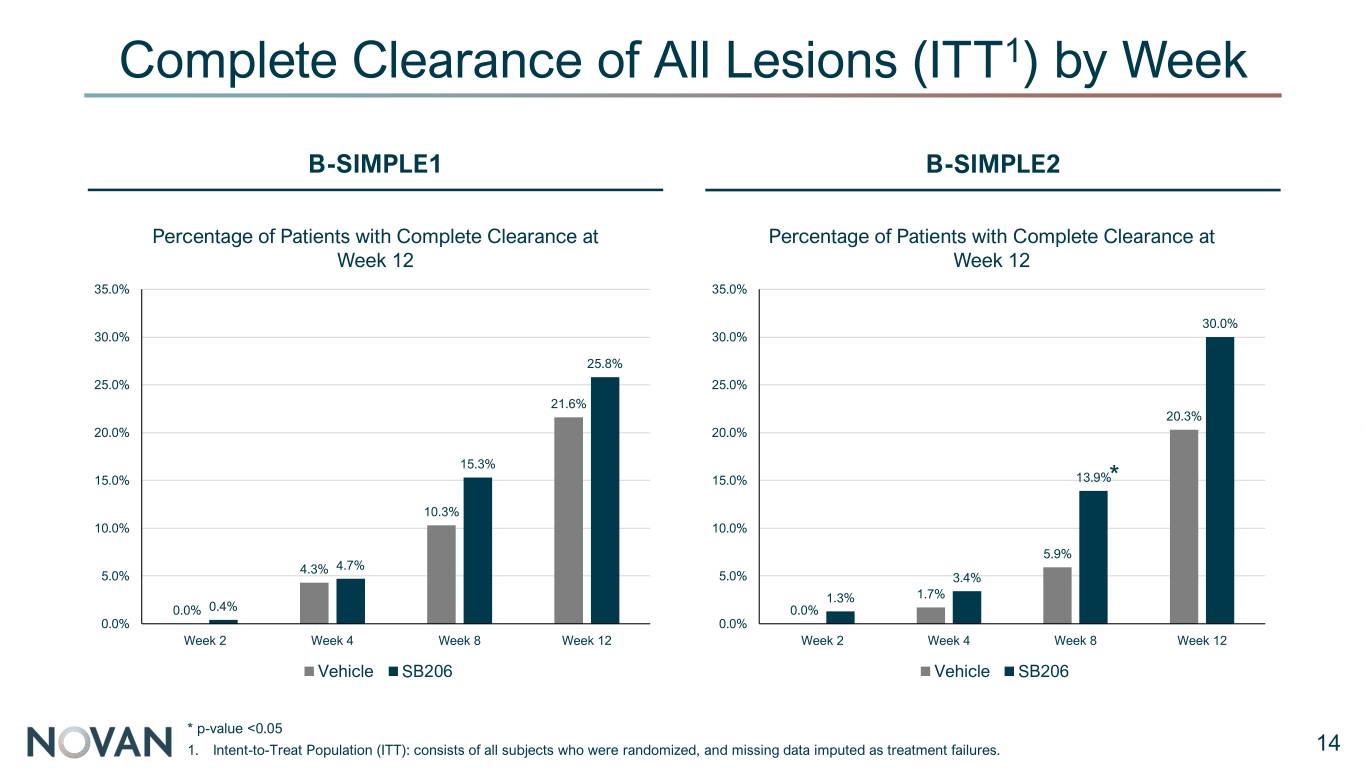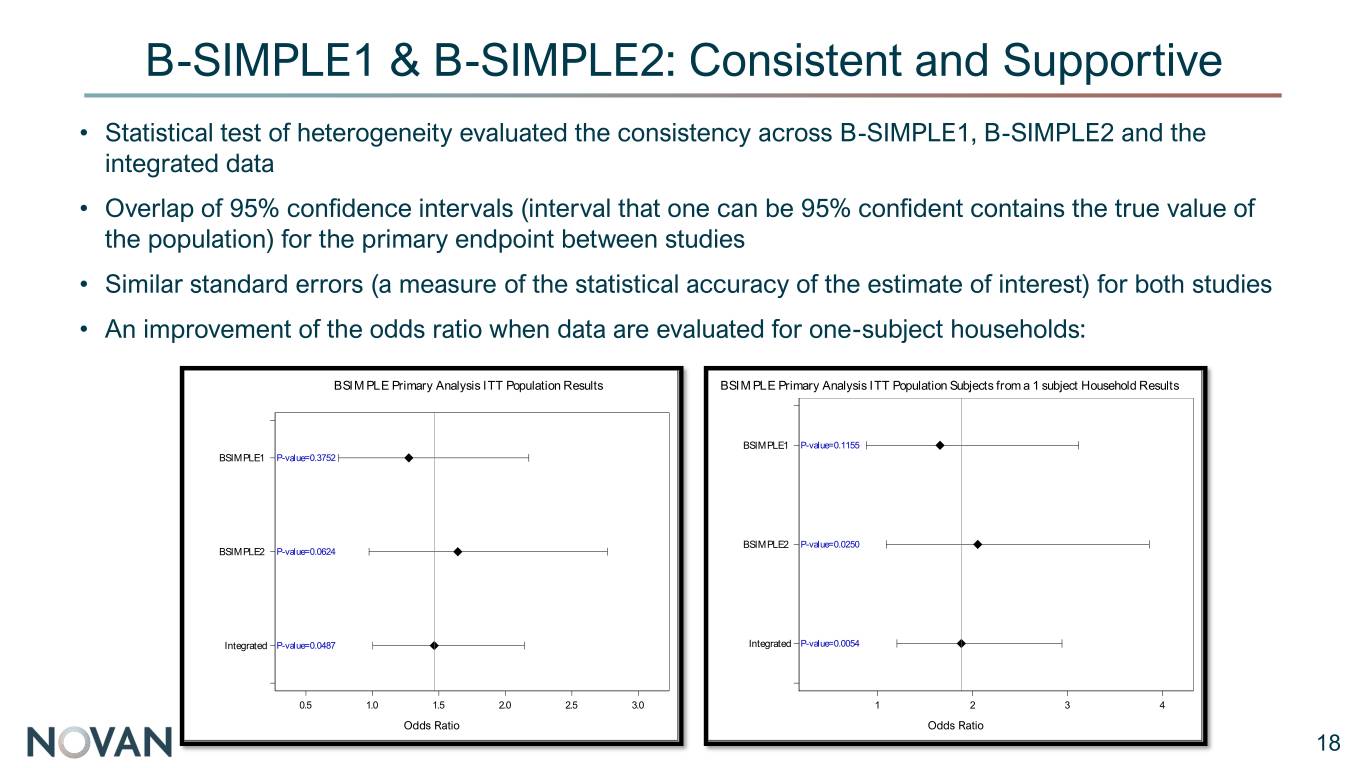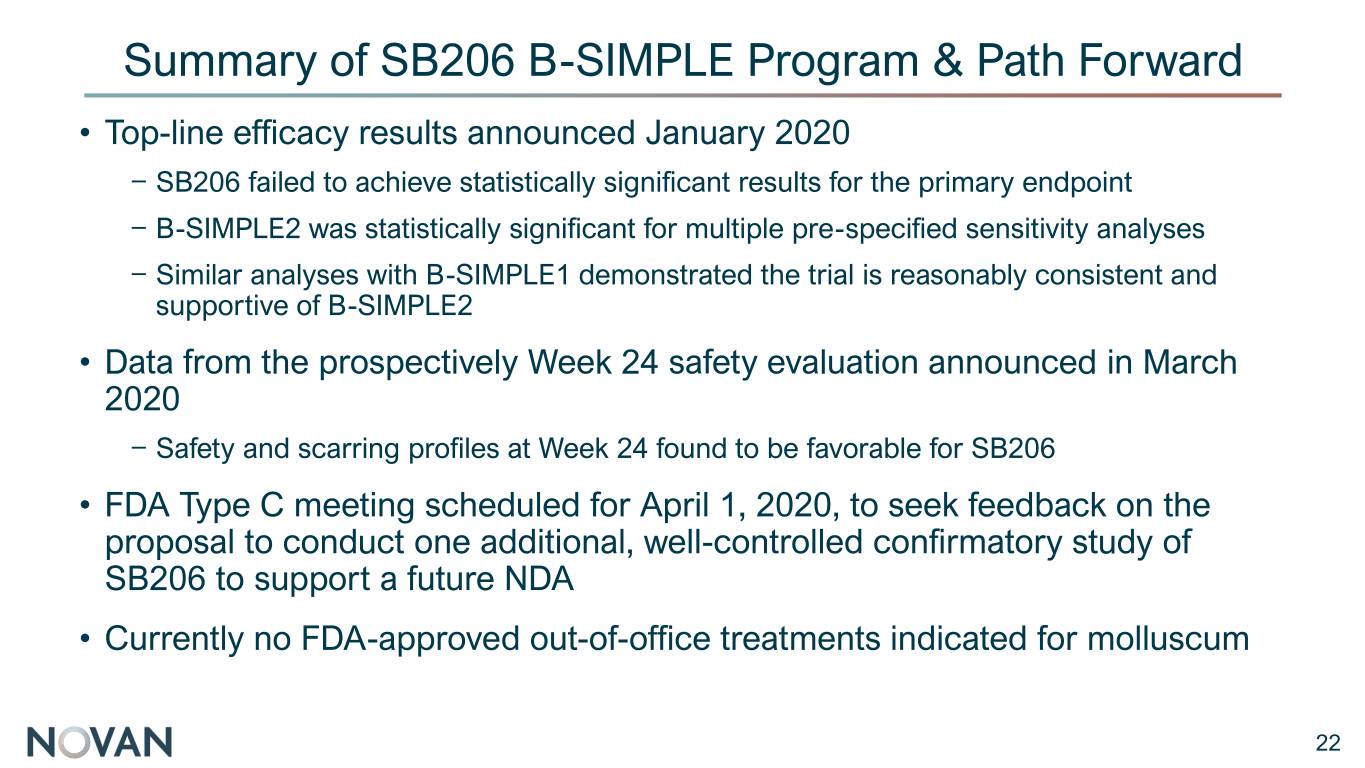Attached files
| file | filename |
|---|---|
| EX-99.1 - EXHIBIT 99.1 - Novan, Inc. | exhibit991.htm |
| 8-K - 8-K - Novan, Inc. | novn-032320208k.htm |

Exhibit 99.2 Corporate Overview March 2020 1

Forward-Looking Statements This presentation includes forward-looking statements that reflect our current views with respect to, among other things, our plans to develop and commercialize our product candidates, including our interpretation of preclinical and clinical studies and the success and timing of our product development activities and clinical trials, such as the timing of full results of our Phase 3 program to evaluate SB206 for the treatment of molluscum contagiosum, the schedule for and outcome of discussions with the U.S. Food and Drug Administration (“FDA”) regarding our B-SIMPLE program, the timing for a third Phase 3 trial, the timing of potential regulatory submissions, and our needs for funding and our intention to pursue financing and strategic alternatives. These forward- looking statements are included throughout this presentation. We have used the words “anticipate,” “assume,” “believe,” “continue,” “could,” “estimate,” “expect,” “intend,” “may,” “plan,” “potential,” “predict,” “project,” “future,” “will,” “seek,” “foreseeable”, “targeted” and similar terms and phrases to identify forward-looking statements in this presentation. The forward-looking statements contained in this presentation are based on management’s current expectations and are subject to substantial risks, uncertainty and changes in circumstances. Actual results may differ materially from these expectations due to risks and uncertainties including, but not limited to: the risk that full results of the Phase 3 program will not be received timely or will not be consistent with our expectations; the risk that disruptions at the FDA and other agencies could cause such agencies to cancel or postpone meetings or otherwise impact the ability of such agencies to provide regulatory guidance or feedback or timely review and process our regulatory submissions, all of which could have a material adverse effect on our business; the risk that the FDA will not agree with our position that the B-SIMPLE2 results can be used to support an NDA alongside results of a third confirmatory trial; the risk that results from a third Phase 3 trial will not be received timely or will not achieve significance sufficient to support an NDA; our ability to obtain funding or enter into strategic relationships on a timely basis, or at all, to enable or complete a third Phase 3 trial and to continue operations; our ability to reduce cash expenditures; risks and uncertainties in the clinical development process, including, among others, length, expense, ability to enroll patients, reliance on third parties, potential for delays and that results of earlier research and preclinical or clinical trials may not be predictive of results, conclusions or interpretations of later research activities or additional trials; risks related to the regulatory approval process, which is lengthy, time- consuming and inherently unpredictable, including the risk that our product candidates may not be approved or that additional studies may be required for approval or other delays may occur and that we may not obtain funding sufficient to complete the regulatory or development process; risks related to the manufacture of clinical trial materials; our ability to obtain additional funding or complete other strategic alternatives necessary to continue our business and/or the further development of our product candidates; and other risks and uncertainties described in our annual report filed with the SEC on Form 10-K for the twelve months ended Dec. 31, 2019, and in any subsequent filings with the SEC. Any forward-looking statement made by us in this presentation speaks only as of the date of this presentation. We undertake no obligation to publicly update or review any forward-looking statement, whether as a result of new information, future developments or otherwise, except as may be required by any applicable securities laws. 2

Proprietary Nitricil™ Technology Creation of macromolecular New Chemical Entities (NCEs) that possess unique nitric oxide (NO) release profiles that can be tailored to different therapeutic uses Analytical Therapeutic Engineered Stable Science Quantities “Tunability” Macromolecule Storage Targeted delivery of Coupling NO Precision release High load capacity NO: minimizes Druggable knowledge with profile unlocks solved: previous systemic exposure formulation of NO toolbox of desired MOA chemistry hurdle and reduces with stability chemistries + disease target backbone toxicity 3

Proprietary Nitricil™ Technology NO NO NO NO NCE NO H20 NO NO NO NO NO NO NO 4

Tunability and Release Profiles Generic Examples Novan Specific NCEs Burst Phase Time NO Time - Real Sustained Phase Release (nmol) Release Time NO Release NO Time - Real Time (Hr) Maximum Sustained Phase Released Burst % of Total NO ofTotal % NO Released NO Phase Cumulative Quantity Cumulative of Time (Hr) 5

Science & Technology Macromolecular platform to achieve stable, tunable and druggable delivery of nitric oxide Stable Tunable Druggable Real-Time Nitric Oxide Release Extended Tail Initial Burst New Chemical Entity (NCE) Proprietary platform enabling development of NCEs with Proprietary formulations, Multiple drug candidates with sustained delivery of nitric targeted to each indication, unique nitric oxide delivery and oxide enable tunable dosing proven target engagement 6

Development Pipeline Product Indication Preclinical Phase 1 Phase 2 Phase 3 Candidates DERMATOLOGY SB206 Molluscum Current focus, progression subject to additional funding and FDA feedback Atopic Dermatitis SB414 Psoriasis SB204 Acne Vulgaris SB208 Tinea Pedis MEN’S AND WOMEN’S HEALTH SB206 Genital Warts WH504 High-Risk HPV Supported by U.S. DoD CDMRP grant WH602 High-Risk HPV Supported by NIH grant GASTROENTEROLOGY Undisclosed Various On Hold 7

Value of Extensive Human Clinical Data SB204 SB206 SB208 SB414 Phase 3 (MC), Phase 2 (TP), Clinical Progress Phase 3 Phase 1b Phase 2 (EGW) Phase 1 (Nail) Tinea pedis, nail Atopic dermatitis, Indications Acne vulgaris Molluscum, EGW growth psoriasis Anti-bacterial, Anti-bacterial, Mechanism of Action Anti-viral Anti-fungal anti-inflammatory anti-inflammatory Peer-Reviewed 2 2 2 0 Clinical Publications Total # of Patients 2410 774 191 58 Treated ~3,400 patients of clinical efficacy/safety data 8

SB206 Phase 3 Study Design (B-SIMPLE1, B-SIMPLE2) • Multi-center, randomized, double-blind, vehicle-controlled, parallel trials to evaluate the efficacy and Description safety of SB206 12% QD for the treatment of molluscum contagiosum (“molluscum” or “MC”) • ~340 subjects per pivotal trial • 2:1 (active:vehicle) randomization • Stratified by investigator type and subjects per household Trial Design • Subjects or their caregivers will apply SB206 12% or Vehicle Gel once daily for a minimum of 4 weeks and up to 12 weeks to all treatable lesions (baseline and new) • Visits at Screening/Baseline, Week 2, Week 4, Week 8, Week 12 and safety follow-up at Week 24 • Males and females, 6 months of age and older Key Inclusion Criteria • 3-70 lesions at baseline Primary Endpoint • Proportion of subjects with complete clearance of all treatable molluscum lesions at Week 12 Secondary Endpoint • Proportion of subjects with complete clearance of all treatable molluscum lesions at Week 8 • Proportion of subjects with complete clearance of all treatable molluscum lesions at each visit • Proportion of subjects achieving clearance of ≥95%, 90% and 75% of molluscum lesions at Week 12 Exploratory • Percent change from baseline in number of molluscum lesions at every visit Endpoints1 • Time to complete clearance • Proportion of subjects who have a recurrence of MC after first visit of complete clearance • Proportion of subjects developing scar(s) after clearance of lesions at each visit Links to clinicaltrials.gov: B-SIMPLE1 & B-SIMPLE2 1. Additional exploratory and sensitivity analysis were defined in the statistical analysis plan 9

Study Demographics1 B-SIMPLE1 B-SIMPLE2 SB206 Vehicle SB206 Vehicle ITT Population2 236 116 237 118 PP Population3 192 109 194 103 Prematurely Discontinued Prior to Week 12 (%) 37 (15.7%) 4 (3.4%) 37 (15.6%) 14 (11.9%) Number of Sites 33 33 % Dermatologists 66.7% 69.7% Age (years) Mean 7.3 6.7 6.3 6.8 % Ages 2 to 17 94.1% 97.4% 97.9% 96.6% Sex Female 50.4% 42.2% 46.4% 52.5% Male 49.6% 57.8% 53.6% 47.5% Baseline Lesion Count Mean 17.8 18.6 18.9 17.1 Median 13.0 13.0 15.0 13.0 Time Since Clinical Diagnosis of Current Episode (Months) Mean 7.1 8.8 7.0 7.2 Median 4.1 5.3 4.6 4.7 1. This table will be updated post completion of Week 24 data analysis and study closeout 2. Intent-to-Treat Population (ITT): consists of all subjects who were randomized 3. Per Protocol (PP): all patients in the ITT population who completed the 12-week treatment period and had no significant protocol deviations that impacted the analyses of 10 efficacy endpoints

Stratification at Randomization1,2 B-SIMPLE1 B-SIMPLE2 SB206 Vehicle SB206 Vehicle # of Subjects Randomized per Household 1 Subject 76.7% 81.4% 2 Subject 23.3% 18.6% # of Subjects Randomized by Investigator Type Dermatologists 60.2% 59.5% 59.9% 61.0% Other 39.8% 40.5% 40.1% 39.0% The Phase 3 B-SIMPLE pivotal trials were well balanced across both studies 1. This table will be updated post completion of Week 24 data analysis and study closeout 11 2. Intent-to-Treat Population (ITT): consists of all subjects who were randomized

Study Disposition1,2 B-SIMPLE1 B-SIMPLE2 SB206 Vehicle SB206 Vehicle Prematurely Discontinued Treatments - Reasons 18.2% 5.2% 19.8% 11.9% Adverse Events 3.0% 0.9% 8.0% 0.8% Lost to Follow Up 8.5% 1.7% 5.9% 8.5% Lack of Efficacy 0.0% 0.0% 0.0% 0.0% Physician Decision 0.0% 0.0% 0.4% 0.0% Withdrawal by Subject Caregiver 5.9% 1.7% 5.1% 2.5% Worsening of Molluscum 0.0% 0.0% 0.0% 0.0% Other 0.8% 0.9% 0.4% 0.0% 1. This table will be updated post completion of Week 24 data analysis and study closeout 12 2. Intent-to-Treat Population (ITT): consists of all subjects who were randomized

B-SIMPLE1 & B-SIMPLE2 Top-Line Results: ITT Population1 B-SIMPLE1 B-SIMPLE2 SB206 Vehicle SB206 Vehicle p-value p-value (n=236) (n=116) (n=237) (n=118) Primary Endpoint: Complete Clearance of 25.8% 21.6% p=0.375 30.0% 20.3% p=0.062 All Lesions at Week 12 Secondary Endpoint: Complete Clearance of 15.3% 10.3% p=0.202 13.9% 5.9% p=0.028 All Lesions at Week 8 SB206 was nearly statistically significant for the primary endpoint compared to vehicle in B-SIMPLE2, and was statistically significant for the secondary endpoint 1. Intent-to-Treat Population (ITT): consists of all subjects who were randomized, and missing data imputed as treatment failures. 13

Complete Clearance of All Lesions (ITT1) by Week B-SIMPLE1 B-SIMPLE2 Percentage of Patients with Complete Clearance at Percentage of Patients with Complete Clearance at Week 12 Week 12 35.0% 35.0% 30.0% 30.0% 30.0% 25.8% 25.0% 25.0% 21.6% 20.3% 20.0% 20.0% 15.3% 15.0% 15.0% 13.9%* 10.3% 10.0% 10.0% 5.9% 4.3% 4.7% 5.0% 5.0% 3.4% 1.3% 1.7% 0.0% 0.4% 0.0% 0.0% 0.0% Week 2 Week 4 Week 8 Week 12 Week 2 Week 4 Week 8 Week 12 Vehicle SB206 Vehicle SB206 * p-value <0.05 1. Intent-to-Treat Population (ITT): consists of all subjects who were randomized, and missing data imputed as treatment failures. 14

Percent Change from Baseline Lesion Count B-SIMPLE1 B-SIMPLE2 10% 10% 0% 0% Week 2 Week 4 Week 8 Week 12 Week 2 Week 4 Week 8 Week 12 -10% -10% -20% -20% * -30% * -30% * -40% -40% -50% -50% * * -60% -60% Vehicle SB206 Vehicle SB206 * * p-value <0.05 15

Sensitivity Analyses and Exploratory Endpoints B-SIMPLE1 B-SIMPLE2 SB206 Vehicle SB206 Vehicle p-value p-value (n=192) (n=109) (n=194) (n=103) PP Primary Endpoint: Complete Population1 Clearance of All Lesions at Week 12 31.3% 21.1% p=0.074 36.1% 23.3% p=0.028 SB206 Vehicle SB206 Vehicle p-value p-value (n=236) (n=116) (n=237) (n=118) Primary Endpoint: Complete Clearance of All Lesions at Week 12 26.7% 21.6% p=0.292 30.8% 20.3% p=0.044 Exploratory Endpoint4: Clearance ITT of 95% Lesions at Week 12 28.0% 22.4% p=0.217 33.8% 20.3% p=0.013 Population2, LOCF3 Exploratory Endpoint4: Clearance of 90% Lesions at Week 12 33.9% 25.0% p=0.079 38.4% 20.3% p<0.001 Exploratory Endpoint4: Clearance of 75% Lesions at Week 12 44.5% 31.9% p=0.028 48.5% 32.2% p=0.004 1. Per Protocol (PP): all patients in the ITT population who completed the 12-week treatment period and had no significant protocol deviations that impacted the analyses of efficacy endpoints 2. Intent-to-Treat Population (ITT): consists of all subjects who were randomized. 3. Last Observation Carried Forward (LOCF) method for handling missing data: all patients randomized (ITT population) and where a patient missed their Week 12 visit their last visit lesion count is included in the analysis as complete/95%/90% clearance at Week 12 16 4. Exploratory endpoints were pre-specified in the statistical analysis plan

Complete Clearance Count at Week 12 (ITT1) by Household Stratification Factor B-SIMPLE1 B-SIMPLE2 SB206 Vehicle SB206 Vehicle p-value p-value n=236 n=116 n=237 n=118 One-Subject Household 28.7% 19.1% p=0.116 29.0% 16.7% p=0.025 n=181 n=89 n=193 n=96 Two-Subject Household 16.4% 29.6% - 34.1% 36.4% - Discordant data was identified in two-subject households across both studies. Subjects from one-subject households contributed to approximately 80% to the overall population. 1. Intent-to-Treat Population (ITT): consists of all subjects who were randomized, and missing data imputed as treatment failures. 17

B-SIMPLE1 & B-SIMPLE2: Consistent and Supportive • Statistical test of heterogeneity evaluated the consistency across B-SIMPLE1, B-SIMPLE2 and the integrated data • Overlap of 95% confidence intervals (interval that one can be 95% confident contains the true value of the population) for the primary endpoint between studies • Similar standard errors (a measure of the statistical accuracy of the estimate of interest) for both studies • An improvement of the odds ratio when data are evaluated for one-subject households: BSIMPLE Primary Analysis ITT Population Results BSIMPLE Primary Analysis ITT Population Subjects from a 1 subject Household Results BSIMPLE1 P-value=0.1155 BSIMPLE1 P-value=0.3752 BSIMPLE2 P-value=0.0250 BSIMPLE2 P-value=0.0624 Integrated P-value=0.0487 Integrated P-value=0.0054 0.5 1.0 1.5 2.0 2.5 3.0 1 2 3 4 Odds Ratio Odds Ratio 18

Overall Summary of AEs (Safety Population) at Week 24 B-SIMPLE1 B-SIMPLE2 SB206 Vehicle SB206 Vehicle (N=235) (N=116) (N=237) (N=117) Subjects with at least one Treatment Emergent 115 (48.9%) 36 (31.0%) 120 (50.6%) 30 (25.6%) Adverse Event (TEAE) Subjects with at least one Serious TEAE 0 0 1 (0.4%) 1 (0.9%) Subjects with at least one treatment-related TEAE 86 (36.6%) 19 (16.4%) 86 (36.3%) 8 (6.8%) Subjects with at least one TEAE leading to Study 7 (3.0%) 1 (0.9%) 17 (7.2%) 1 (0.9%) Drug Discontinuation Subjects with a TEAE leading to Death 0 0 0 0 Maximum Severity Mild 60 (25.5%) 25 (21.6%) 51 (21.5%) 18 (15.4%) Moderate 50 (21.3%) 10 (8.6%) 63 (26.6%) 11 (9.4%) Severe 5 (2.1%) 1 (0.9%) 6 (2.5%) 1 (0.9%) 19

Summary of Treatment-Emergent Adverse Event (Safety Population) at Week 24 B-SIMPLE1 B-SIMPLE2 SB206 Vehicle SB206 Vehicle (N=235) (N=116) (N=237) (N=117) System Organ Class/Preferred Term Subjects[1] Events Subjects[1] Events Subjects[1] Events Subjects[1] Events Subjects with at least one TEAE 115 (48.9%) 261 36 (31.0%) 64 120 (50.6%) 306 30 (25.6%) 53 General disorders and administration site 88 (37.4%) 184 22 (19.0%) 33 84 (35.4%) 204 17 (14.5%) 26 conditions Application site pain 51 (21.7%) 66 8 (6.9%) 9 37 (15.6%) 57 2 (1.7%) 7 Application site erythema 29 (12.3%) 41 3 (2.6%) 3 26 (11.0%) 43 0 0 Application site scar 6 (2.6%) 6 9 (7.8%) 9 10 (4.2%) 10 10 (8.5%) 10 Pyrexia 11 (4.7%) 12 4 (3.4%) 5 7 (3.0%) 7 2 (1.7%) 4 Application site exfoliation 10 (4.3%) 16 0 0 9 (3.8%) 17 0 0 Application site pruritus 11 (4.7%) 12 0 0 8 (3.4%) 8 2 (1.7%) 3 Application site swelling 6 (2.6%) 8 1 (0.9%) 1 7 (3.0%) 9 0 0 Application site dermatitis 5 (2.1%) 7 1 (0.9%) 1 11 (4.6%) 12 1 (0.9%) 1 Application site discolouration 5 (2.1%) 5 0 0 3 (1.3%) 3 1 (0.9%) 1 Application site irritation 4 (1.7%) 4 0 0 4 (1.7%) 5 0 0 [1] At each level of summation (overall, system organ class, preferred term), subjects reporting more than one adverse event are counted only once. 20

SB206 Impact on Scarring Number of Subjects (%) with Scarring by Visit (ITT Population) B-SIMPLE1 B-SIMPLE2 SB206 Vehicle SB206 Vehicle (N=236) (N=116) (N=237) (N=118) Week 4 0 0 8 (3.4%) 6 (5.1%) Week 8 7 (3.0%) 7 (6.0%) 7 (3.0%) 9 (7.6%) Week 12 6 (2.5%) 4 (3.4%) 12 (5.1%) 12 (10.2%) Week 24 11 (4.7%) 11 (9.5%) 22 (9.3%) 14 (11.9%) Subjects treated with SB206 showed a lower occurrence of scarring consistently through the Week 24 visit when compared to vehicle Note: scarring was determined by the investigator and the definition of scar comprises any size scar including molluscum pitted scars/indentations that are natural course of resolution. 21

Summary of SB206 B-SIMPLE Program & Path Forward • Top-line efficacy results announced January 2020 − SB206 failed to achieve statistically significant results for the primary endpoint − B-SIMPLE2 was statistically significant for multiple pre-specified sensitivity analyses − Similar analyses with B-SIMPLE1 demonstrated the trial is reasonably consistent and supportive of B-SIMPLE2 • Data from the prospectively Week 24 safety evaluation announced in March 2020 − Safety and scarring profiles at Week 24 found to be favorable for SB206 • FDA Type C meeting scheduled for April 1, 2020, to seek feedback on the proposal to conduct one additional, well-controlled confirmatory study of SB206 to support a future NDA • Currently no FDA-approved out-of-office treatments indicated for molluscum 22

Funding and Operations Commentary • Cash and cash equivalents of ~$13.7M as of 12/31/19 • Announced closing of $5.95M public offering on 3/3/20 • The Company continues to explore both financial as well as strategic options in order to continue operations and to progress SB206 for the molluscum indication • Substantial additional funding will be required in order to progress SB206 for the molluscum indication, subject to FDA feedback, and to continue to sustain business operations 23
